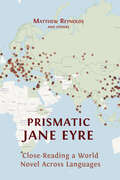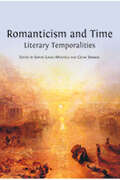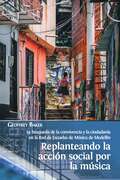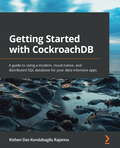- Table View
- List View
The Hope of Israel (The Littman Library of Jewish Civilization)
by Menasseh Ben-IsraelWhen The Hope of Israel was translated into English in 1652, its argument from Scripture that messianic redemption would not come to the Jewish people until they were scattered in all the corners of the Earth aroused great interest and played an instrumental part in the discussions in the Commonwealth under Cromwell which eventually led to the readmission of the Jews in 1656. This edition of that English text includes an introduction and notes which place the work in the intellectual context of its time.
Tener Demasiado: Ensayos Filosóficos sobre el Limitarismo
by Ingrid Robeyns'Tener demasiado' es el primer volumen académico dedicado al limitarismo: la idea de que el uso de los recursos económicos o de los ecosistemas no sobrepasen ciertos límites. <br> Se trata de un concepto profundamente arraigado en el pensamiento económico y político, por lo que es posible encontrar premisas similares en pensadores como Platón, Aquino o Spinoza. No obstante, 'Tener demasiado' es el primer ejemplar en el campo de la filosofía política contemporánea en el que el limitarismo se explora en profundidad y con detalle. <br> Asimismo, este estudio reúne por primera vez los mejores escritos de los principales teóricos del limitarismo, lo que le convierte en una contribución esencial al campo de la filosofía política, en general, y de las teorías sobre la justicia distributiva, en particular. Incluye tanto artículos seminales ya publicados como nuevos capítulos y se presenta como lectura indispensable para académicos y estudiantes de teoría política y filosofía, así como para todos aquellos interesados en cuestiones relacionadas con la justicia distributiva.
Calderon: Love is no laughing matter (Aris & Phillips Hispanic Classics)
by Sean PageAlthough Calderon's comedy has received rather less attention than the other genres in which he excelled, it is widely acknowledged that his comic plays are inrivalled among his contemporaries in terms of plot structure and technical expertise; they also explore contemporary issues to an extent which has not been appreciated. Love is no Laughing Matter is one of the best, in which the dramatist casts a sardonic eye on male chauvinism, women's education and social snobbery. This is the first complete text of the play to be published since 1650. Spanish text with facing-page translation.
Lorca: Mariana Pineda (Aris & Phillips Hispanic Classics)
Mariana Pineda (1925) was Lorca's first success in the theatre. Based on a popular Andalusian ballad, it tells the story of Mariana Pineda who was garrotted in 1831 under the reactionary regime of Ferdinand VII for embroidering a Liberal flag and refusing to betray her lover. Written during the dictatorship of Primo de Rivera, the political message would not have escaped Lorca's audience. But the play is primarily the work of a poet and its appeal lies in the delicate tension that results from a deft blend of lyricism and drama which culminates in an astonishing level of spirituality in the final scenes when Mariana awaits her execution in a prison-convent. The characteristic themes of Lorca's tragedies - love, frustration, fate, freedom, death and womanhood - flourish within the play's appropriate and exquisite romantic mood. Spanish text with facing-page translation, introduction and commentary.
Tirso de Molina: Don Gil of the Green Breeches (Aris & Phillips Hispanic Classics)
Tirso de Molina enjoys enduring popularity as a writer of irreverent comedies, though his critical reputation as a major dramatist rests largely on his more serious works. Don Gil of the Green Breeches as befits a high farce is much concerned with disguise, mistaken identity, role-reversal, ghosts, and trousers! Dona Juana, jilted by her lover Don Martin, follows him to Madrid, where, under the assumed name of Don Gil, he is courting the wealthy Dona Ines. Dressed as a man in a distinctive pair of green breeches, Dona Juana also masquerades as Don Gil. Don Martin is outwitted by his transvestite rival, who wrecks his schemes like a maleficent will-'o-the-wisp before leading him, shell-shocked, to the altar! In his lively, accurate and fluent line-by-line verse translation of this play Gordon Minter admirably conveys the unique flavour of Tirso's sparkling wit. Additionally, in his stimulating Introduction and Commentary he argues that this effervescent drama deliberately subverts the Don Juan legend to show that the Trickster of Seville's female counterpart can be just as resourceful and predatory when the restoration of her honour is at stake. The further revelation that Don of the Green Breeches has unobtrusively and unnoticed contributed an important strand to subsequent European versions of the Don Juan legend completes a scholarly reappraisal of the significance of a work too often regarded as little more than a highly amusing dramatic confection.
Buero Vallejo: A Dreamer for the People (Aris & Phillips Hispanic Classics)
Buero Vallejo is Spain's most important living playwright. His profound, innovative theatre has earned him success and respect since 1949. Each new play has been an exciting experiment with dramatic form as well as a powerful expression of a tragic view of human life and Spanish society. A Dreamer for the People was first performed in 1958. In this history play, the first of a remarkable series, culminating in La detonacion ( The Shot also published by Aris & Phillips), the dreamer of the title is the often maligned Marquis of Esquilache, the reformist minister of Carlos III. Buero sets off Esquilache's relations with the king, the aristocracy, his wife and his maidservant against a lively re-creation of the build-up to the famous 1766 Capes and Hats Revolt in the streets of Madrid. Public history and private tragedy are brought together in a complex structure, bringing into clear focus the clash between forces of change and immobility that lay at the heart of both the 18th century and the Franco period in Spain. In returning his proofs, Buero compliments the author of this first translation into English of his play: 'La version de Mr Thompson es muy cuidada y fiel, asi como acertadas y oportunas sus notas'.
Decolonial Ecologies: The Reinvention of Natural History in Latin American Art
by Joanna PageIn Decolonial Ecologies: The Reinvention of Natural History in Latin American Art, Joanna Page illuminates the ways in which contemporary artists in Latin America are reinventing historical methods of collecting, organizing, and displaying nature in order to develop new aesthetic and political perspectives on the past and the present.
Decolonial Ecologies: The Reinvention of Natural History in Latin American Art
by Joanna PageIn Decolonial Ecologies: The Reinvention of Natural History in Latin American Art, Joanna Page illuminates the ways in which contemporary artists in Latin America are reinventing historical methods of collecting, organizing, and displaying nature in order to develop new aesthetic and political perspectives on the past and the present.
Prismatic Jane Eyre: Close-Reading a World Novel Across Languages
by Matthew Reynolds OthersJane Eyre, written by Charlotte Brontë and first published in 1847, has been translated more than five hundred times into over sixty languages. Prismatic Jane Eyre argues that we should see these many re-writings, not as simple replications of the novel, but as a release of its multiple interpretative possibilities: in other words, as a prism. Prismatic Jane Eyre develops the theoretical ramifications of this idea, and reads Brontë’s novel in the light of them: together, the English text and the many translations form one vast entity, a multilingual world-work, spanning many times and places, from Cuba in 1850 to 21st-century China; from Calcutta to Bologna, Argentina to Iran. Co-written by many scholars, Prismatic Jane Eyre traces the receptions of the novel across cultures, showing why, when and where it has been translated (and no less significantly, not translated – as in Swahili), and exploring its global publishing history with digital maps and carousels of cover images. Above all, the co-authors read the translations and the English text closely, and together, showing in detail how the novel’s feminist power, its political complexities and its romantic appeal play out differently in different contexts and in the varied styles and idioms of individual translators. Tracking key words such as ‘passion’ and ‘plain’ across many languages via interactive visualisations and comparative analysis, Prismatic Jane Eyre opens a wholly new perspective on Brontë’s novel, and provides a model for the collaborative close-reading of world literature. Prismatic Jane Eyre is a major intervention in translation and reception studies and world and comparative literature. It will also interest scholars of English literature, and readers of the Brontës.
Prismatic Jane Eyre: Close-Reading a World Novel Across Languages
by Matthew Reynolds OthersJane Eyre, written by Charlotte Brontë and first published in 1847, has been translated more than five hundred times into over sixty languages. Prismatic Jane Eyre argues that we should see these many re-writings, not as simple replications of the novel, but as a release of its multiple interpretative possibilities: in other words, as a prism. Prismatic Jane Eyre develops the theoretical ramifications of this idea, and reads Brontë’s novel in the light of them: together, the English text and the many translations form one vast entity, a multilingual world-work, spanning many times and places, from Cuba in 1850 to 21st-century China; from Calcutta to Bologna, Argentina to Iran. Co-written by many scholars, Prismatic Jane Eyre traces the receptions of the novel across cultures, showing why, when and where it has been translated (and no less significantly, not translated – as in Swahili), and exploring its global publishing history with digital maps and carousels of cover images. Above all, the co-authors read the translations and the English text closely, and together, showing in detail how the novel’s feminist power, its political complexities and its romantic appeal play out differently in different contexts and in the varied styles and idioms of individual translators. Tracking key words such as ‘passion’ and ‘plain’ across many languages via interactive visualisations and comparative analysis, Prismatic Jane Eyre opens a wholly new perspective on Brontë’s novel, and provides a model for the collaborative close-reading of world literature. Prismatic Jane Eyre is a major intervention in translation and reception studies and world and comparative literature. It will also interest scholars of English literature, and readers of the Brontës.
An Outline of Romanticism in the West
by John Claiborne IsbellNavigating the landscape of Romantic literature and art across Europe and the Americas, An Outline of Romanticism in the West invites readers to embark upon a literary journey.
An Outline of Romanticism in the West
by John Claiborne IsbellNavigating the landscape of Romantic literature and art across Europe and the Americas, An Outline of Romanticism in the West invites readers to embark upon a literary journey.
Replanteando la acción social por la música
by Geoffrey Baker¿Cómo podemos comprender mejor el pasado, el presente y el futuro de la Acción Social por la Música (ASPM)? <p><p> Este libro pionero examina el desarrollo de La Red de Escuelas de Música de Medellín, una red de 27 escuelas fundada en 1996 en la segunda ciudad principal de Colombia como respuesta a su reputación como la ciudad más peligrosa en la Tierra. Inspirada en El Sistema, el programa venezolano fundacional de educación musical, La Red es, no obstante, notablemente diferente: su historia es una de múltiples reinvenciones y de una búsqueda continua para mejorar su oferta educativa y alcanzar mejor sus objetivos sociales. Sus reflexiones internas e intentos de transformación arrojan luz valiosa sobre el pasado, el presente y el futuro de ASPM. <p> Basado en un año de trabajo de campo intensivo en Colombia y escrito por Geoffrey Baker, autor de El Sistema: Orchestrating Venezuela’s Youth (2014), este importante volumen ofrece nuevas perspectivas sobre ASPM y su evolución tanto en el ámbito académico como en la práctica. Será de interés para un público muy variado: empleados y líderes de programas ASPM; educadores musicales; patrocinadores y responsables políticos; y estudiantes y académicos de campos como ASPM, la educación musical, la etnomusicología y otros campos relacionados.
Replanteando la acción social por la música: la búsqueda de la convivencia y la ciudadanía en la Red de Escuelas de Música de Medellín
by Geoffrey Baker¿Cómo podemos comprender mejor el pasado, el presente y el futuro de la Acción Social por la Música (ASPM)? Este libro pionero examina el desarrollo de La Red de Escuelas de Música de Medellín, una red de 27 escuelas fundada en 1996 en la segunda ciudad principal de Colombia como respuesta a su reputación como la ciudad más peligrosa en la Tierra. Inspirada en El Sistema, el programa venezolano fundacional de educación musical, La Red es, no obstante, notablemente diferente: su historia es una de múltiples reinvenciones y de una búsqueda continua para mejorar su oferta educativa y alcanzar mejor sus objetivos sociales. Sus reflexiones internas e intentos de transformación arrojan luz valiosa sobre el pasado, el presente y el futuro de ASPM. Basado en un año de trabajo de campo intensivo en Colombia y escrito por Geoffrey Baker, autor de El Sistema: Orchestrating Venezuela’s Youth (2014), este importante volumen ofrece nuevas perspectivas sobre ASPM y su evolución tanto en el ámbito académico como en la práctica. Será de interés para un público muy variado: empleados y líderes de programas ASPM; educadores musicales; patrocinadores y responsables políticos; y estudiantes y académicos de campos como ASPM, la educación musical, la etnomusicología y otros campos relacionados.
Getting Started with Cockroachdb: A Guide to Implementing a Modern Cloud-nativeand Distributed Sql Database for Your Data-intensive Apps (PDF)
by Kishen Das Kondabagilu RajannaGetting Started with CockroachDB will introduce you to the inner workings of CockroachDB and help you to understand how it provides faster access to distributed data through a SQL interface. The book will also uncover how you can use the database to provide solutions where the data is highly available. Starting with CockroachDB's installation, setup, and configuration, this SQL book will familiarize you with the database architecture and database design principles. You'll then discover several options that CockroachDB provides to store multiple copies of your data to ensure fast data access. The book covers the internals of CockroachDB, how to deploy and manage it on the cloud, performance tuning to get the best out of CockroachDB, and how to scale data across continents and serve it locally. In addition to this, you'll get to grips with fault tolerance and auto-rebalancing, how indexes work, and the CockroachDB Admin UI. The book will guide you in building scalable cloud services on top of CockroachDB, covering administrative and security aspects and tips for troubleshooting, performance enhancements, and a brief guideline on migrating from traditional databases. By the end of this book, you'll have gained sufficient knowledge to manage your data on CockroachDB and interact with it from your application layer.
Tirso de Molina: Tamar's Revenge (Aris & Phillips Hispanic Classics)
The story comes from the Second Book of Samuel and tells of the incestuous passion of Amnon, David's eldest son, for his half-sister, Tamar and the subsequent murder of Amnon by his brother Absolom. Amnon's lust is set in the context of complementary passions of ambition and revenge, reflected in Absolom and Tamar respectively. The play explores King David's conflict between justice and mercy when confronted with these tragic events. It is a work of constantly changing perspectives in which tragedy and comedy, instead of being simply juxtaposed, are blended in a highly original way. Tirso's play is one of the earliest treatments of a theme that has continued to be an inspiration for such modern writers as the novelist Dan Jacobson in The Rape of Tamar and the dramatist Peter Shaffer in Jonadab . Spanish text with facing-page translation, commentary and notes.
Valle Inclan: The Lights of Bohemia (Aris & Phillips Hispanic Classics)
by John LyonWritten in the early 1920s, Lights of Bohemia is set in the twilight phase of Madrid's bohemian artistic life against the turbulent social and political background of events between 1900 and 1920. The play's protagonist, the poet Max Estrella, confronts the dilemma between art and social commitment and the problem of salvaging some sort of authenticity and identity in a context which converts him into an anachronism. This is the first play in a series of 'esperpentos' or 'grotesques' in which Valle-Inclan tries to convey the tragi-grotesque contradictions of his contemporary surroundings by the use of similarly contrasting registers in his theatre.
Valle Inclan: Esperpento De Los Cuernos De Don Friolera (Aris & Phillips Hispanic Classics)
by Robin Warner Dominic KeownIt may well be the sheer virtuosity of its writing that has deprived English audiences hitherto of an opportunity to appreciate Los cuernos de Don Friolera . This comic masterpiece by Spain's most innovative modern dramatist provides a provocatively sardonic treatment of marital infidelity and honourable revenge. Intricate in construction and thoughtful in the issues it raises, the play is nonetheless vivid in its impact as it veers disconcertingly between witty debate, uproarious farce and ludicrously overblown melodrama. The traditions and institutions which, in the 1920s (and, in some cases, for most of this century), blocked Spain's path to modernization and progress are mercilessly lampooned. The translation seeks to convey the dramatic point of the dialogue, its innuendos, allusions and shifts of register, rather than a strict literalness.
Calderon: The Painter of his Dishonour, El pintor de su deshonra (Aris & Phillips Hispanic Classics)
Alan Paterson presents Calderon's original text, from manuscript and printed sources, with a skilful verse translation into English of a remarkable play, in which Calderon develops the motif of marital honour in quite original ways. The blending of deep pathos and humour anticipates the modern theatre of the absurd, though Calderon is pushing to the limits the license gained by Lope de Vega to mingle tragedy with comedy. The play incorporates important aesthetic ideas of the Renaissance on painting and the character of the artist. It must be unique in seventeenth-century European in dramatising the painter as he works in his studio and meditates on his art. Since the play deals with the aesthetic component in human behaviour, its own aeathetic status as a verse drama had been conserved in the translation. Those with no knowledge of Spanish will find a text which is agreeable to read and to perform. The translation is close enough, however, to offer the reader of limited ability in Spanish a reliable key to the Spanish text. Spanish text with facing-page translation, introduction and commentary.
Lorca: Gypsy Ballads (Aris & Phillips Hispanic Classics)
by Robert G. HavardLorca's famous Gypsy Ballads were composed in the 1920s, when his poetic style was evolving from the traditional towards the surrealist. The combination of the ballad's perennial narrative format with startling and allusive imagery has intrigued readers ever since. Dr Havard argues that the fatalism and tribalism of the gypsy settings relate to Lorca's own subjective dilemma and sexual anxieties, and that they ultimately make a deeply personal statement. The translations are broadly into free verse which aims to preserve the directness and the rhythm of the Spanish original so that the force of the poems may be appreciated by English readers. 162p
Calderon: The Schism in England: La cisma de Inglaterra (Aris & Phillips Hispanic Classics)
by Kenneth MuirAdmired by Shelley for 'its satisfying completeness', this thought-provoking and skilfully constructed play, which dramatizes the same subject as Shakespeare's Henry VIII , is one of its creator's most outstanding achievements. Understandably, Calderon offers an interpretation of King Henry's divorce from Catherine of Aragon and break with the Church of Rome which is markedly different from that given in Shakespeare's work. Yet, despite his Counter-Reformation allegiances, Calderon brings Henry VIII sympathetically to dramatic life. The schismatic English monarch is portrayed by the Roman Catholic Spanish playwright as a man endowed with moral awareness and with exceptional talent for spiritual leadership, who is, nevertheless, morally and spiritually destroyed by his extraordinary surrender to the forces of physical passion. In this first published translation of the play into English Kenneth Muir and Ann MacKenzie have adhered to methods effectively adopted in their previous books ( Four Comedies by Calderon, and Three Comedies by Calderon). They have composed, almost entirely in blank verse, an accurate yet elegantly poetic version, after the manner of the Elizabethans, but avoiding vocabulary which might seem affected to a modern audience, in order to produce a 'script' that could be performed with success on the stage. The critical edition, prepared by Ann Mackenzie to accompany the translation, is based on the editio princeps (published by Vera Tassis in Calderon's Octava parte de comedias [Madrid, 1684]). Her substantial Introduction and comprehensive Commentary together constitute the most detailed critical evaluation accomplished to date of this key-drama from the Golden Age in Spain. The Introduction, in particular, supplies new evidence as to the date of the play (1627) and the circumstances of its composition, and provides an analysis of Calderon's creative treatment of his historical source-work: Ribadeneyra's Historia eclesiastica del cisma del reino de Inglaterra (1588). Spanish text with facing-page translation, introduction and commentary .
Lope de Vega: Fuente Ovejuna (Aris & Phillips Hispanic Classics)
Fuente Ovejuna (C.1613) is the most famous and frequently performed play by the creator of Spanish theatre, Lope de Vega (1562-1635). Astonishingly for its period, it celebrates the murder in 1476 of a nobleman, the Grand Commander of the Military Order of Calatrava, by the peasants he had oppressed, and their subsequent solidarity under torture. Fuente Ovejuna , however, is less a history lesson or political tract than an optimistic moral fable. Spanish text with facing-page translation, introduction and notes.
Francisco de Quevedo: Dreams and Discourses (Aris & Phillips Hispanic Classics)
The Suenos is one of the most controversial, witty and fantastic works of early 17th century Spanish literature. The five Dreams minutely analyse stupidity, ignorance and evil, as these could be found in contemporary society. The work's serious moral intention, often masked by the author's pointed anger, scabrous wit, wide learning, love of verbal gymnastics and surreal flights of imaginative fantasy, has for 350 years presented a challenge to the translator and the student of Hispanic culture outside the Spanish speaking world. This first full English translation of the Suenos since 1688 is accompanied by the Spanish text, and Dr Britton's own introduction and notes help the modern reader to understand the numerous historical and literary references, to elucidate the various linguistic devices and to sketch in the intellectual, moral and religious background of the text. Spanish text with facing-page translation, introduction and notes.
Spanish Ballads (Aris & Phillips Hispanic Classics)
by Roger WrightThe Spanish ballad tradition is one of the largest and most colourful in Europe, as reflected in the present collection of 71 of the best examples. They include tales of love and adventure, ancient legends such as those of Rodrigo the last Visigothic king, the battle of Roncesvalles and Bernardo del Carpio, stirring accounts of events of Spanish History such as the life of the Cid and the reign of Pedro "the cruel", as well as the "frontier ballads" about the relations between the Christians and the Moslems. Roger Wright's brilliantly performable verse translations closely recapture the style of the originals and make the meaning and spirit of the mediaeval ballad tradition come alive. His careful transcriptions of the Spanish texts and his detailed historical and linguistic notes provide a valuable insight into this splendid tradition. Spanish text with facing-page English translation.




